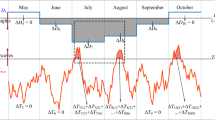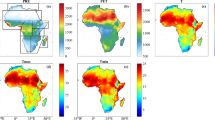Abstract
Global warming has accelerated surface water loss around the world. This study investigates in detail the change and attribution of potential evapotranspiration (PET) across China from 1901 to 2100 by the Hargreaves model, based on a 1-km temperature dataset downscaled from the low-spatial-resolution datasets using a Delta downscaling framework. Results showed that (1) relative to 1961–1990, PET increased by 0.62% in the historic period (1901–2017) and 6.43–12.89% for the future period (2018–2100), suggesting considerable future drying for China. Moreover, these increments had strong spatial variations and the largest increases were detected in high-elevation regions; (2) PET over entire China demonstrated a nonsignificant upward trend during the historic period and significant upward trends for the future period. For each period and GCM, significant upward PET trends occupied a much larger percent area than significant downward trends; (3) PET variations during the historic period were most sensitive to mean temperature (TMP), while in the future period it was more sensitive to maximum temperature (TMX), suggesting a change in the primary sensitivity factor due to global warming; (4) minimum temperature (TMN) made the largest contribution (45%) to PET variations during the historic period, while TMX had the largest contribution (36–40%) in the future period. Therefore, the primary contributing factor might transform from TMN to TMX under climate change; and (5) PET variations exhibited strong spatial heterogeneity, detected on fine geographic scales, due to the use of downscaled dataset. Overall, the results present a deep insight for planning coping strategies of global warming in China.











Similar content being viewed by others
References
Allen RG, Pereira LS, Raes D, Smith M (1998) Crop evapotranspiration-guidelines for computing crop water requirements-FAO Irrigation and drainage paper 56. FAO, Rome 300: D05109
Aouissi J, Benabdallah S, Lili Chabaâne Z, Cudennec C (2016) Evaluation of potential evapotranspiration assessment methods for hydrological modelling with SWAT—application in data-scarce rural Tunisia. Agric Water Manag 174:39–51. https://doi.org/10.1016/j.agwat.2016.03.004
Brekke L, Thrasher B, Maurer E, Pruitt T (2013) Downscaled CMIP3 and CMIP5 climate and hydrology projections: release of downscaled CMIP5 climate projections, comparison with preceding information, and summary of user needs. US Dept. of the Interior, Bureau of Reclamation, Technical Services Center, Denver, Colorado
Budyko MI (1974) Climate and life. Academic, New York
Chai R, Sun S, Chen H, Zhou S (2018) Changes in reference evapotranspiration over China during 1960–2012: attributions and relationships with atmospheric circulation. Hydrol Process 32:3032–3048. https://doi.org/10.1002/hyp.13252
Chang XM, Wang SL, Gao ZY, Luo YF, Chen HR (2019) Forecast of daily reference evapotranspiration using a modified daily Thornthwaite equation and temperature forecasts. Irrig Drain 68:297–317. https://doi.org/10.1002/ird.2309
Chen L, Frauenfeld OW (2014) A comprehensive evaluation of precipitation simulations over China based on CMIP5 multimodel ensemble projections. J Geophys Res 119:5767–5786. https://doi.org/10.1002/2013JD021190
Cook BI, Smerdon JE, Seager R, Coats S (2014) Global warming and 21st century drying. Clim Dyn 43:2607–2627. https://doi.org/10.1007/s00382-014-2075-y
Fan JL, Yue WJ, Wu LF, Zhang FC, Cai HJ, Wang XK, Lu XH, Xiang YZ (2018) Evaluation of SVM, ELM and four tree-based ensemble models for predicting daily reference evapotranspiration using limited meteorological data in different climates of China. Agric For Meteorol 263:225–241. https://doi.org/10.1016/j.agrformet.2018.08.019
Fick SE, Hijmans RJ (2017) WorldClim 2: new 1-km spatial resolution climate surfaces for global land areas. Int J Climatol 37:4302–4315. https://doi.org/10.1002/joc.5086
Gao L, Wei J, Wang L, Bernhardt M, Schulz K, Chen X (2018) A high-resolution air temperature data set for the Chinese Tian Shan in 1979–2016. Earth Syst Sci Data 10:2097–2114. https://doi.org/10.5194/essd-10-2097-2018
Giorgi F, Jones C, Asrar GR (2009) Addressing climate information needs at the regional level: the CORDEX framework. World Meteorol Org Bull 58:175–183
Han JY, Wang JH, Zhao Y, Wang QM, Zhang B, Li HH, Zhai JQ (2018) Spatio-temporal variation of potential evapotranspiration and climatic drivers in the Jing-Jin-Ji region, North China. Agric For Meteorol 256:75–83. https://doi.org/10.1016/j.agrformet.2018.03.002
Hargreaves GH, Allen RG (2003) History and evaluation of Hargreaves evapotranspiration equation. J Irrig Drain Eng 129:53–63. https://doi.org/10.1061/(asce)0733-9437(2003)129:1(53)
Hargreaves GH, Samani ZA (1985) Reference crop evapotranspiration from temperature. Appl Eng Agric 1:96–99
Harris I, Jones P, Osborn T, Lister D (2014) Updated high–resolution grids of monthly climatic observations–the CRU TS3.10 dataset. Int JClimatol 34:623–642. https://doi.org/10.1002/joc.3711
Hawkins E, Sutton R (2011) The potential to narrow uncertainty in projections of regional precipitation change. Clim Dyn 37:407–418. https://doi.org/10.1007/s00382-010-0810-6
IPCC, 2013 Climate Change 2013: The physical science basis. Contribution of Working Group I to the Fifth Assessment Report of the Intergovernmental Panel on Climate Change [Stocker, T.F., D. Qin, G.-K. Plattner, M. Tignor, S.K. Allen, J. Boschung, A. Nauels, Y. Xia, V. Bex and P.M. Midgley (eds.)]. Cambridge University Press, Cambridge, United Kingdom and New York, NY, USA, pp. 1535
Jiang S, Liang C, Cui N, Zhao L, Du T, Hu X, Feng Y, Guan J, Feng Y (2019) Impacts of climatic variables on reference evapotranspiration during growing season in Southwest China. Agric Water Manag 216:365–378. https://doi.org/10.1016/j.agwat.2019.02.014
Li Y, Liu C, Yu W, Tian D, Bai P (2019) Response of streamflow to environmental changes: a Budyko-type analysis based on 144 river basins over China. Sci Total Environ 664:824–833. https://doi.org/10.1016/j.scitotenv.2019.02.011
Liu B, Huang Z, Chen X, Wang Z (2019) Effects of large-scale climate anomalies on crop reference evapotranspiration in the main grain-production area of China. Int J Climatol 39:1195–1212. https://doi.org/10.1002/joc.5871
McCuen RH (1974) A sensitivity and error analysis of procedures used for estimating evaporation. JAWRA Journal of the American Water Resources Association 10:486–497. https://doi.org/10.1111/j.1752-1688.1974.tb00590.x
Mosier TM, Hill DF, Sharp KV (2014) 30-Arcsecond monthly climate surfaces with global land coverage. Int J Climatol 34:2175–2188. https://doi.org/10.1002/joc.3829
Naumann G, Alfieri L, Wyser K, Mentaschi L, Betts RA, Carrao H, Spinoni J, Vogt J, Feyen L (2018) Global changes in drought conditions under different levels of warming. Geophys Res Lett 45:3285–3296. https://doi.org/10.1002/2017gl076521
Ning L, Bradley RS (2015) Snow occurrence changes over the central and eastern United States under future warming scenarios. Sci Rep 5:17073
Ning L, Bradley RS (2016) NAO and PNA influences on winter temperature and precipitation over the eastern United States in CMIP5 GCMs. Clim Dyn 46:1257–1276. https://doi.org/10.1007/s00382-015-2643-9
Ning T, Li Z, Liu W, Han X (2016) Evolution of potential evapotranspiration in the northern loess plateau of China: recent trends and climatic drivers. Int J Climatol 36:4019–4028. https://doi.org/10.1002/joc.4611
Odusanya AE, Mehdi B, Schurz C, Oke AO, Awokola OS, Awomeso JA, Adejuwon JO, Schulz K (2019) Multi-site calibration and validation of SWAT with satellite-based evapotranspiration in a data-sparse catchment in southwestern Nigeria. Hydrol Earth Syst Sci 23:1113–1144. https://doi.org/10.5194/hess-23-1113-2019
Peng S, Li Z (2018) Incorporation of potential natural vegetation into revegetation programmes for sustainable land management. Land Degrad Dev 29:3503–3511. https://doi.org/10.1002/ldr.3124
Peng S, Ding Y, Wen Z, Chen Y, Cao Y, Ren J (2017) Spatiotemporal change and trend analysis of potential evapotranspiration over the loess plateau of China during 2011–2100. Agric For Meteorol 233:183–194. https://doi.org/10.1016/j.agrformet.2016.11.129
Peng S, Gang C, Cao Y, Chen Y (2018) Assessment of climate change trends over the loess plateau in China from 1901 to 2100. Int J Climatol 38:2250–2264. https://doi.org/10.1002/joc.5331
Peng S, Yu K, Li Z, Wen Z, Zhang C (2019) Integrating potential natural vegetation and habitat suitability into revegetation programs for sustainable ecosystems under future climate change. Agric For Meteorol 269–270:270–284. https://doi.org/10.1016/j.agrformet.2019.02.023
Priestley CHB, Taylor RJ (1972) On the assessment of surface heat flux and evaporation using large-scale parameters. Mon Weather Rev 100:81–92. https://doi.org/10.1175/1520-0493(1972)100<0081:otaosh>2.3.co;2
Reclamation, 2013 Downscaled CMIP3 and CMIP5 climate and hydrology projections: release of downscaled CMIP5 climate projections, comparison with preceding information, and summary of user needs. the U.S. Department of the Interior, Bureau of Reclamation, Technical Services Center, Denver, Colorado, pp. 47
Tian Y, Zhang KJ, Xu YP, Gao XC, Wang J (2018) Evaluation of potential evapotranspiration based on CMADS reanalysis dataset over China. Water 10:17. https://doi.org/10.3390/w10091126
Wang L, Chen W (2014) A CMIP5 multimodel projection of future temperature, precipitation, and climatological drought in China. Int J Climatol 34:2059–2078. https://doi.org/10.1002/joc.3822
Wang Z, Ye A, Wang L, Liu K, Cheng L (2019) Spatial and temporal characteristics of reference evapotranspiration and its climatic driving factors over China from 1979 to 2015. Agric Water Manag 213:1096–1108. https://doi.org/10.1016/j.agwat.2018.12.006
Xu Y, Wu Y, Xu G (2019) Variation of reference evapotranspiration and its teleconnection with multiple large-scale climate oscillations in the Yangtze River Delta, China. Int J Climatol 39:2630–2645. https://doi.org/10.1002/joc.5977
Yang Q, Ma Z, Zheng Z, Duan Y (2017) Sensitivity of potential evapotranspiration estimation to the Thornthwaite and penman–Monteith methods in the study of global drylands. Adv Atmos Sci 34:1381–1394. https://doi.org/10.1007/s00376-017-6313-1
Zhao C, Nan Z, Feng Z (2004) GIS-assisted spatially distributed modeling of the potential evapotranspiration in semi-arid climate of the Chinese loess plateau. J Arid Environ 58:387–403. https://doi.org/10.1016/j.jaridenv.2003.08.008
Zheng H, Liu X, Liu C, Dai X, Zhu R (2009) Assessing contributions to panevaporation trends in Haihe River Basin, China. Journal of Geophysical Research: Atmospheres 114: D24105. .1029/2009jd012203
Acknowledgements
The historical and future 30′ temperature data were obtained from Climatic Research Unit (https://sites.uea.ac.uk/cru/data) and Downscaled CMIP5 Climate and Hydrology Projections (https://gdo-dcp.ucllnl.org), respectively. The high-spatial-resolution temperature dataset with 0.5′ was obtained from the WorldClim v. 2.0 (https://www.worldclim.org/). The observed temperature and pan evaporation data were obtained from the National Meteorological Information Center of China (http://data.cma.cn/en). We would like to thank these organizations for providing valuable climate datasets.
Availability of data and material
The datasets used or analyzed during the current study are available from the corresponding author on reasonable request.
Code availability
Not applicable.
Funding
This work was supported by the National Natural Science Foundation of China (42077451) and the Natural Science Foundation of Shaanxi Province, China (2020JQ-418).
Author information
Authors and Affiliations
Contributions
Yongxia Ding conducted the modeling, performed the analysis, and drafted the manuscript. Shouzhang Peng designed the study, interpreted the results, and supervised the research.
Corresponding author
Ethics declarations
Ethics approval
Not applicable.
Consent to participate
Not applicable.
Consent for publication
Not applicable.
Conflict of interest
The authors declare no competing interests.
Additional information
Publisher’s note
Springer Nature remains neutral with regard to jurisdictional claims in published maps and institutional affiliations.
Supplementary Information
ESM 1
(DOCX 2766 kb)
Rights and permissions
About this article
Cite this article
Ding, Y., Peng, S. Spatiotemporal change and attribution of potential evapotranspiration over China from 1901 to 2100. Theor Appl Climatol 145, 79–94 (2021). https://doi.org/10.1007/s00704-021-03625-w
Received:
Accepted:
Published:
Issue Date:
DOI: https://doi.org/10.1007/s00704-021-03625-w




